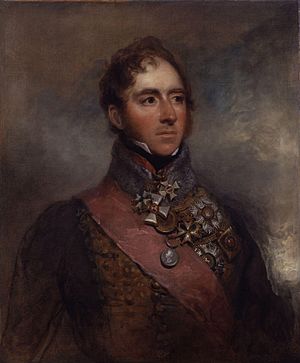Henry Wellesley, 1st Baron Cowley facts for kids
Quick facts for kids Henry Wellesley |
|
|---|---|
|
|
|
| Spouse(s) | Lady Charlotte Cadogan Lady Georgiana Cecil |
| Issue | |
| Henry Wellesley, 1st Earl Cowley William Wellesley Gerald Wellesley |
|
| Father | Garret Wesley, 1st Earl of Mornington |
| Mother | Anne Hill-Trevor |
| Born | 20 January 1773 |
| Died | 27 April 1847 |
Henry Wellesley, 1st Baron Cowley (GCB) was an important British diplomat and politician. He was born on January 20, 1773, and passed away on April 27, 1847.
Henry was the younger brother of Arthur Wellesley, who became the famous Duke of Wellington. The Duke was a great soldier and politician. Henry's career was often linked to his older brothers, Arthur and Richard. Richard was even the Foreign Secretary for a few years.
Henry is especially known for his work as the British Ambassador to Spain. This was during the Peninsular War, a big conflict in Europe. He worked closely with his brother Arthur to get support from the Spanish government. Later, Henry also served as Ambassador in Vienna, Austria, and then in Paris, France.
His first marriage ended in divorce, which caused some public discussion at the time.
Contents
Early Life and School
Henry Wellesley was the fifth and youngest son in his family. His father was Garret Wellesley, 1st Earl of Mornington. His mother was Anne Hill-Trevor. Both families were from Ireland.
Henry went to Eton College, a famous school in England. He also spent time at the court of the Duke of Brunswick. In 1790, he joined the army as an ensign.
Henry Wellesley's Diplomatic Career
Henry's journey as a diplomat started in 1791. He became an assistant at the British embassy in The Hague. The next year, he worked as a secretary in Stockholm, Sweden.
In 1794, Henry was traveling home from Lisbon, Portugal. He was captured by the French during a very difficult time called the Reign of Terror. Luckily, he managed to escape in 1795.
Later that year, he became a Member of Parliament in Ireland. In 1807, he was elected to the British Parliament. He chose to represent the Eye area in England. He kept this role until 1809.
Working in India and Europe
In 1797, Henry went to India. There, he became the private secretary to his oldest brother, Lord Mornington. His brother was the new governor-general of India.
Henry helped his brother with many diplomatic tasks. He helped negotiate important agreements with places like Mysore and Oudh. He was in India from 1797 to 1799, and again from 1801 to 1802.
In 1802, Henry returned to Europe. The next year, he married Lady Charlotte Cadogan. They had three sons and one daughter. Their marriage ended in divorce in 1810.
Ambassador to Spain
In 1809, Henry became the British envoy to Spain. At this time, his oldest brother, Richard, was the Foreign Secretary. His brother Arthur (who became Viscount Wellington) was leading the British and Portuguese armies in Spain.
The three brothers worked together to help the Peninsular campaign succeed. In 1812, Henry was knighted for his work. He stayed as Ambassador to Spain until 1821. During this time, he married again. His second wife was Lady Georgiana Cecil.
Later Diplomatic Roles
In 1823, Henry became the Ambassador to Austria. He stayed there until 1831. He knew the Foreign Secretary, George Canning, quite well.
In January 1828, Henry was given the title Baron Cowley. This was thanks to his brother Wellington's influence.
His last diplomatic job was in Paris, France. He served as the British Ambassador to France from 1835 to 1846. In 1846, Henry retired from his work. He remained in Paris and passed away there the next year.
Henry Wellesley's Family
Henry Cowley first married Lady Charlotte in 1803. She was the daughter of Charles Cadogan, 1st Earl Cadogan. They divorced in 1810.
He later married Lady Georgiana Cecil. She was the daughter of the Marquess of Salisbury.
Henry's oldest son was Henry Richard Charles Wellesley. He also became a diplomat, just like his father. He served as the ambassador in Paris for 15 years. He was later given the title Earl Cowley.
Another son, Gerald Valerian Wellesley, became the Dean of Windsor. His second son, William, became a captain in the Royal Navy.
Images for kids
-
Henry's elder brother Richard Wellesley helped his diplomatic career.
See also
 In Spanish: Henry Wellesley para niños
In Spanish: Henry Wellesley para niños



